 Last week I shared Pixar’s 22 Rules of Phenomenal Storytelling, and I’m going to be honest and say that when you’re at the very beginning of writing a story, it can be overwhelming looking at that list and knowing where to start. But as promised, I’m going to walk you through the process as I go through it myself, and these past two weeks I’ve started firmly with character, loving every discovery and where it’s leading.
Last week I shared Pixar’s 22 Rules of Phenomenal Storytelling, and I’m going to be honest and say that when you’re at the very beginning of writing a story, it can be overwhelming looking at that list and knowing where to start. But as promised, I’m going to walk you through the process as I go through it myself, and these past two weeks I’ve started firmly with character, loving every discovery and where it’s leading.
Check out some of Pixar’s rules that have to do with character:
#6 What is your character good at, comfortable with? Throw the polar opposite at them. Challenge them. How do they deal?
#13 Give your characters opinions. Passive/malleable characters might seem likeable to you as you write, but it’s poison to the audience.
#15 If you were your character, in this situation, how would you feel? Honesty lends credibility to unbelievable situations.
When I wrote my first novels, I had no idea how to figure those things out. I muddled through it in the dark, as if blindly trying to distinguish characters’ features by mauling them with my hands. It wasn’t until several (okay, six) drafts into my second novel that I hit on three secrets that have turned character development into a straight-forward science.
You can utilize these three secrets at any writing stage, whether you have no idea what your story will be or you’ve already completed six drafts. I’ve done it in both cases (as mentioned) and found these three steps invaluable either way.
And, okay, technically each step has two parts, but they go hand-in-hand.
The first step is …
*drumroll*
Photoboothing and Energy Typing
“Wait, what?” you’re saying.
Don’t worry. I’ll explain.
When I start a story, I have only the vaguest notion where I’m headed. It’s usually a tiny suspicion of the dynamics I want to explore—like the relationship between two sisters in my first novel, or the relationship between a group of friends in my second novel—and I think to myself,
“What would make these relationships interesting?”
You don’t even need to answer that question yet; just keep it in mind as you go. Ready?
PART 1: PHOTOBOOTHING
Begin by making avatars of your characters.
This is the avatar generator I use (click image to follow link), but you could pick any you like. The goal of this step is to play! Don’t be too logical about it, because playing is the best way to access creativity. Play around with features until you feel that surreal sensation of “Yes! That’s the character I’m looking for!”
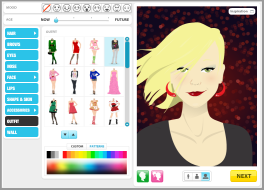
Maybe you recognize some quality—sharpness or softness, openness or aloofness, determination or malleability—that would fit the relationship you’ve got in mind and make it interesting. In other words, you’re beginning to answer the question above.
Next, open another tab and do the same thing for your second character. Play with features again, and this time you have the added dimension of playing off the first character.
For example, are these characters bosom buddies with tons in common? Or are they total opposites who will pose a challenge to each other throughout the story (think rule #6)? Even in this easy, initial step, you can see a lot. If I take that sharp-looking, sophisticated female above and want to give her a challenge, I might pair her with a soft-and-comfy kind of boy who prefers to hang out in sweats.
Then I play a little more. I try out different expressions to see what these characters look like in different situations. Sometimes I discover they have super animated faces with a wide range of expressions; other times the changes are slight and subtle.
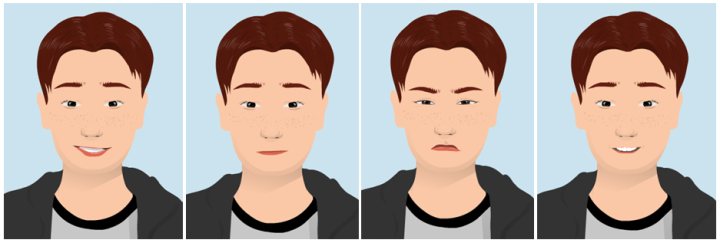
By photoboothing them (a verb I made up), I begin to catch a glimpse of what they’re like.
You can see why I start here, right? The whole picture-is-worth-a-thousand-words concept is extra valuable when you’ve got nothing. Way better than muddling through a bunch of text-only scenes to get to know them. This is instant. Like a Polaroid.
Aaaannnddd … it can tell you way more than you realize—if you analyze your new photofriends via energy typing.
PART 2: ENERGY TYPING
Remember how I mentioned softness vs sharpness etc? Energy typing is a system that matches physical characteristics to personality traits, so once you know what your character looks like, you’ve got incredible insight into who they are as well.
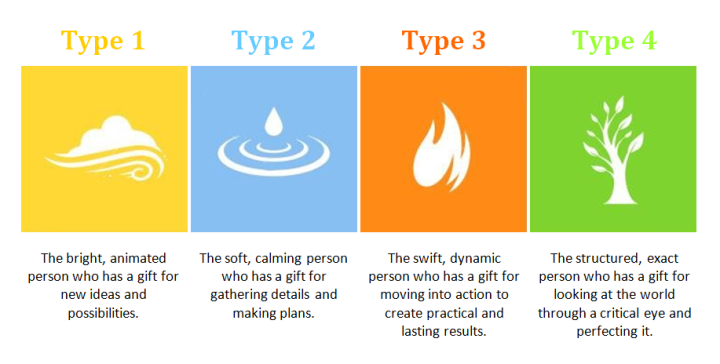
With practice, it’s easy to tell a person’s type from his or her appearance:
TYPE 1 Upward energy: cute, bright, random, childlike features = FUN
TYPE 2 Downward energy: soft, subtle, curvy, blended features = SENSITIVE
TYPE 3 Outward energy: sharp, strong, rough, dynamic features = DETERMINED
TYPE 4 Inward energy: straight, long, symmetrical, striking features = SERIOUS

 The female avatar has sharp eyes, a sharp mouth, a sharp chin—obviously a type 3—while the guy has a soft chin, subtle eyes, blended cheeks—a definite type 2. Looking more carefully, you can even spot each one’s secondary trait. The girl has striking hair, skin and eyes plus a long neck, suggesting a secondary type 4; the boy has childlike freckles and an asymmetrical mouth, suggesting a secondary type 1. So we would call her a 3/4 and him a 2/1 and know that we have a determined/serious female character and a sensitive/fun-loving male one.
The female avatar has sharp eyes, a sharp mouth, a sharp chin—obviously a type 3—while the guy has a soft chin, subtle eyes, blended cheeks—a definite type 2. Looking more carefully, you can even spot each one’s secondary trait. The girl has striking hair, skin and eyes plus a long neck, suggesting a secondary type 4; the boy has childlike freckles and an asymmetrical mouth, suggesting a secondary type 1. So we would call her a 3/4 and him a 2/1 and know that we have a determined/serious female character and a sensitive/fun-loving male one.
(By the way, these characters are up for grabs. They aren’t the ones I’m using for my next novel; I just made them as examples, so if they inspire you, have at them.)
With those two numbers—dominant and secondary energy—you can use the chart below to discover a wealth of personality information about your characters.
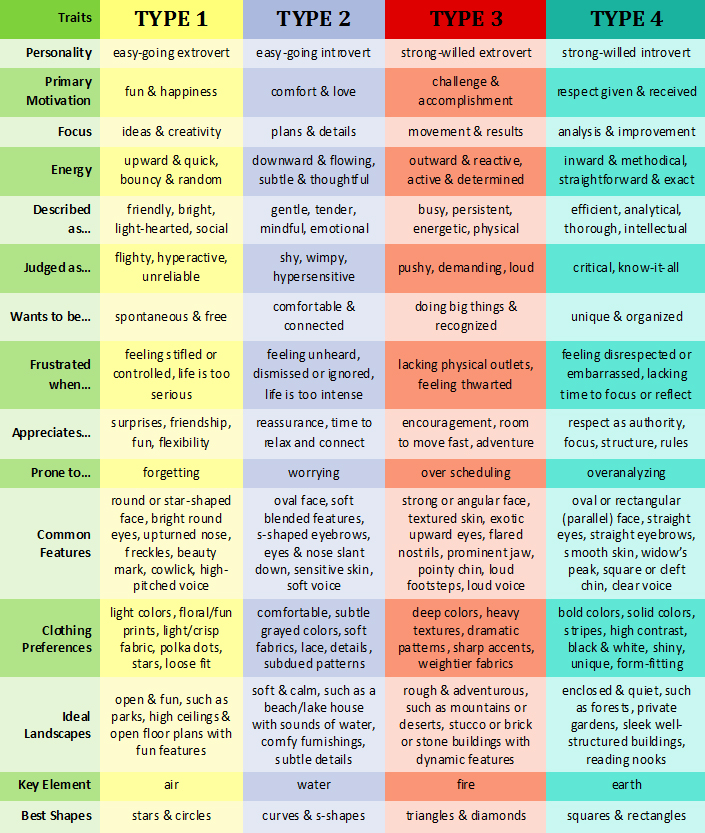
Believe it or not, this works on real people too! For example, I am a 4/1, which explains my long, serious face but also random features—such as a section of brown in an otherwise green eye, a cowlick, and gumdrop-shaped teeth—that give my seriousness a goofy, childlike side. Analyzing yourself, family and friends will give you more insight into how these traits manifest in different ways for different people.
(If you want to delve even deeper, I recommend Carol Tuttle’s book The Child Whisperer. While she has others addressing these concepts, The Child Whisperer feels the most comprehensive. You can also go to Carol Tuttle’s YouTube channel to view a treasure trove of videos exploring the four energy types.)
Stay tuned for the next step, in which we’ll dive into “Names and Nomenology,” followed by step three, “Astrology and Numerology.” I guarantee that by the end you’ll be amazed at how complex your characters have become and how well you understand them!
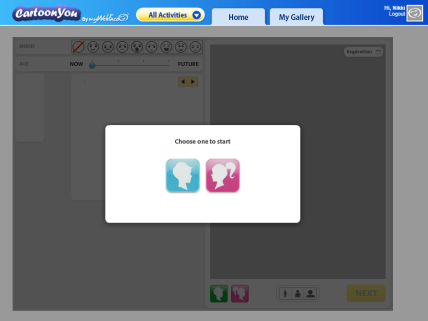
2 thoughts on “Three Steps to Complex Characters (Part I)”